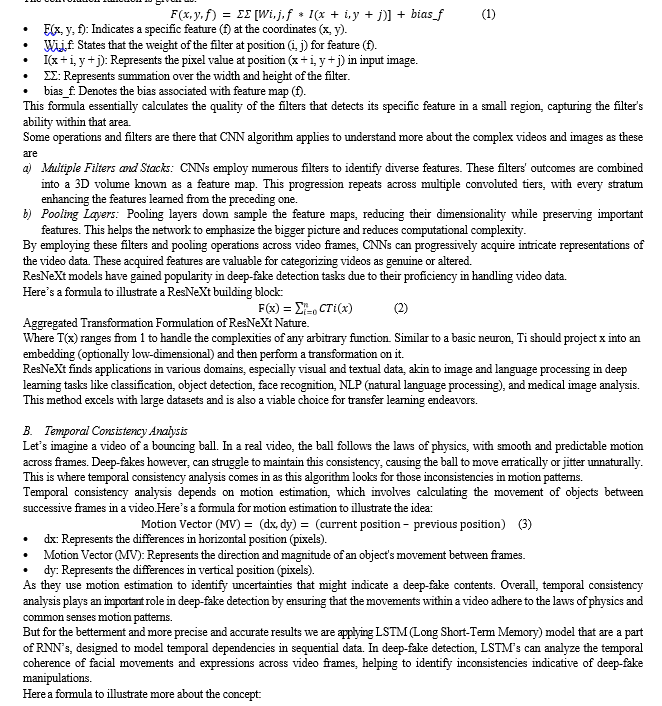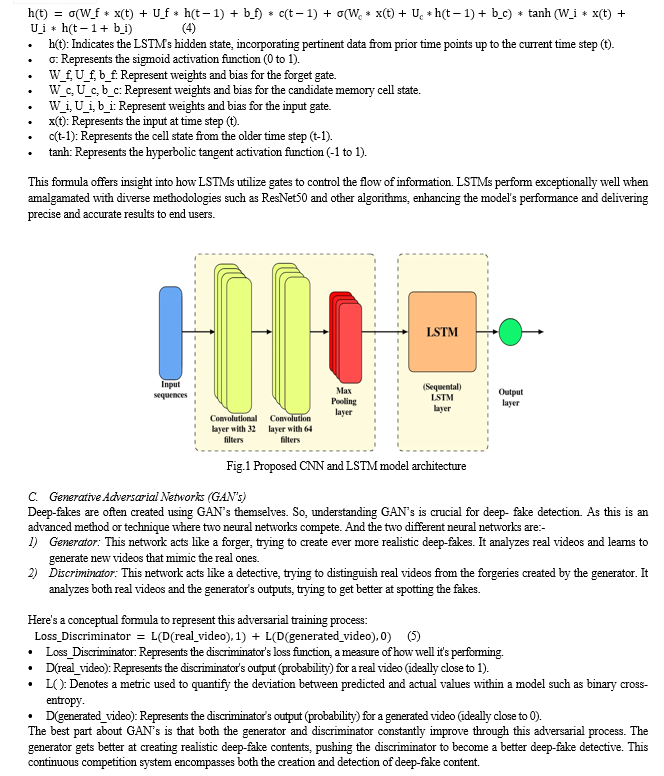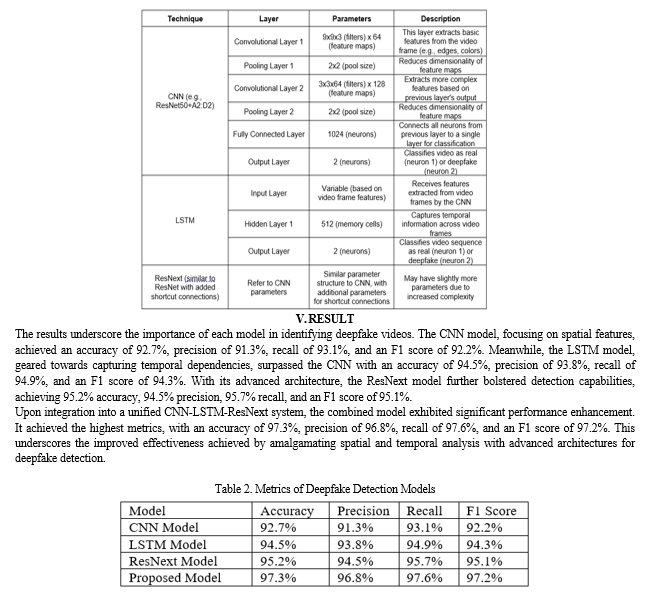Ijraset Journal For Research in Applied Science and Engineering Technology
- Home / Ijraset
- On This Page
- Abstract
- Introduction
- Conclusion
- References
- Copyright
Video Authenticity Detection Using Web-Enabled Techniques
Authors: Rahul Anand, Lavanya Santhosh , Dr. Asha K N, Veena Potdar, Ritik Kumar, Rohit Raj, Siddharth Sharma
DOI Link: https://doi.org/10.22214/ijraset.2024.62881
Certificate: View Certificate
Abstract
In light of the pervasive threat posed by deepfake videos in the digital realm, this study delves into the expansion of an innovative deepfake detection system. Leveraging state-of-the-art AI methodologies, including CNN’s, LSTM networks, and ResNext architectures, our research seeks to improve the precision and efficiency of deepfake identification. Departing from traditional manual inspection approaches, our suggested system integrates automated, real-time monitoring functionalities to swiftly identify and flag suspicious content. Through an exhaustive review of existing literature and methodologies, we identify key gaps and challenges in current detection methods, offering novel solutions to address them. This study contributes a unique combatting deepfake proliferation.
Introduction
I. INTRODUCTION
The digital age, fuelled by advancements in Artificial Intelligence (AI), has made it imperative to pinpoint and counter the threat of deepfake videos. The rampant creation of deepfakes, powered by technologies like CNN’s , LSTM networks, and ResNext architectures, significantly undermines the credibility and authenticity of online content. These manipulated videos can seamlessly alter both visuals and audio, weaving deceptive narratives that can be utilized to spread misinformation and manipulate audiences across various online platforms. In our current hyper-connected world, where online media and social networks reign supreme, deepfakes pose a significant risk to public opinion, political discourse, and organizational reputations. Developing robust deepfake detection methods that leverage techniques like CNNs, LSTMs, and ResNext is critical to maintaining trust and ensuring the legitimacy of digital platforms. This detection process acts as a vital safeguard against the spread of false information, preventing potential harm, and upholding the integrity of online media content. The ever-growing sophistication of deepfake generation techniques, coupled with the explosion of digital content, presents a formidable challenge in accurately discerning between genuine and manipulated videos. Traditional detection methods often fall short in the face of these advanced algorithms, leading to issues like incorrectly identifying real videos as deepfakes and missing actual deepfakes altogether. Therefore, there is an urgent need for automated and scalable deepfake detection solutions that harness the power of CNNs, LSTMs, and ResNext to effectively combat these challenges. These techniques or methods are essential for guaranteeing the reliability and accuracy of digital media content, ultimately fostering a more trustworthy online environment.
II. RELATED WORK
Through the past few years, the challenges of deepfakes has gained popularity because of the increasing availability of computer-based editing tools. As a consequence, the devlopment of efficient techniques for discerning these adulterated contents must be done quickly. Here, we recap ongoing works devoted to detecting deepfakes, which could be taken as a reference framework for the project we propose.
As Rajalaxmi et al. [1] highlighted, it is vital to examine deep fakes; this can be done to secure national security, democracy, and privacy. Using InceptionResNetV2 in their model as a CNN (Convolutional Neural Network) feature, they aim at recognizing the difference between authentic and deepfake images. In accordance with the paper of Patel et al. [2], AI tools can create deepfake videos easily and they have presented a framework for categorizing diverse kinds of deepfakes using the neural network technology. Awareness of detection difficulties and detection technologies as mitigation measures of deepfake risks were emphasized. Saber et al. [3] underlined deepfake face-swapping methods that are popular drawbacks and surveyed the detection methods through spatial and temporal attributes. The experimental model showed encouraging outcomes when put to test on other data sets. Almars et al., [4] emphasized on the technique of image and video forging through deepfakes, which showcased the superiority of deep learning techniques such as CNN, RNN and LSTM in catching the fake content.
The paper highlighted those issues related to frame information loss and the improvement in the deepfake quality as well. Tu and others [5] introduced a DCNN (deep convolutional neural network) model, which used CNN to detect deepfake videos and achieved optimal outcomes on the Celeb-DF (v2) dataset. Their researches covered the impossibility for a human being to distinguish between deepfake videos and real ones.
According to Tambe et al. [6], the team developed a system which employs artificial intelligence techniques and smart contracts in tracing the source and track record of digital content with an emphasis on video content. Besides the above research, our project also incorporates the deep learning approaches in order to achieve the higher detection accuracy than existing models. As opposed to this, we use Res-Next for video frame analysis that extract features to pinpoint these minute irregularities that hint at deepfake manipulation. Moreover, Long Short-Term Memory (LSTM) networks are skilled to capture temporal information along video sequences, which is necessary for the detection of uncertainty introduced by deepfake creation tools. Several studies in the past have also investigated the combination of ResNet50 and LSTM to optimize the precision of deepfake detection [7]. Doke et al. [8] investigated the temporal dissonance introduced by deep fake creation tools that were done using CNNs (Convolutional Neural Networks) and RNNs (Recurrent Neural Networks). Mary and Edison et al. [9] conducted a review on deepfake detection through various deep learning techniques, focusing on the challenges deepfakes present and the significance of correct detection methods. Amerini and Caldelli et al. [10] presented a sequence-based approach based on LSTM models to distinguish manipulated videos from original videos which achieved encouraging preliminary results. Taviti et al. [11] introduced an AI method for video authentication which ResNext CNN and LSTM are a part of, examining the model accuracy with different sequence lengths. Their research proved the societal implications of deepfakes and the need for more reliable detection. In short, these studies help us both to learn from past achievements and to serve as benchmarks towards sophisticated machine learning strategies for spotting deepfake content.
A. Existing System
Presently, the recognition of deepfake videos heavily relies on manual inspection and traditional computer vision methodologies. Experts in the field meticulously scrutinize video content, looking for signs of manipulation such as inconsistencies in facial expressions or unnatural audio synchronization. This method is capable of generating results in certain situations, it is time-consuming, requires a significant amount of human effort, and is susceptible to errors. Additionally, with advancements in deepfake technology, conventional detection methods are becoming less reliable, making it increasingly difficult to differentiate between genuine and manipulated videos.
B. Proposed System
Our designed system aims to advance the identification of deepfake videos through the implementation of state-of-the-art AI algorithms, including CNN’s , LSTM networks, and ResNext architectures. These sophisticated algorithms will be trained on extensive datasets comprising both authentic and manipulated videos to discern patterns and features indicative of deepfake manipulation. Leveraging the capability of deep learning, our system will autonomously analyze video content, identifying subtle cues and anomalies suggestive of tampering.
Furthermore, our system will integrate real-time monitoring capabilities to detect deepfake videos immediately upon their upload to online platforms. By continuously scanning for suspicious content, the system can promptly flag potential deepfakes for further scrutiny by human moderators. This proactive approach facilitates swift intervention to alleviate the dissemination of misinformation and safeguard the integrity of online media content
III. THEORETICAL FUNDAMENTALS
In this project, we utilize a specific algorithm or method within CNNs to effectively classify videos, minimizing errors in image or video selection. This method, known as ResNeXt, falls under the category of CNN architectures tailored to mitigate issues like gradient diminishment, which can hinder training in deep networks. Deep-fakes are often created using GAN’s themselves. So, understanding GAN’s is crucial for deep- fake detection.
A. Convolutional Neural Network
CNN’s act like our highly trained image analysts against deep-fakes. Let’s imagine a video frame as a crime scene with potential signs of forgery. CNNs work by applying multiple filters, like specialized magnifying glasses, that can scan the image for specific details. These filters can detect things like variations in skin texture, inconsistencies in lighting, or unnatural blinking patterns.
As CNNs learn these details through a mathematical process called convolution. This involves calculating how well each filter matches specific characteristics in the image. By stacking these filter outputs and applying them across multiple layers, CNNs build a complex understanding of the video data. This allows them to identify subtle unpredictability that might indicate a deep-fake, ultimately helping us separate the real from the artificial ones.
The convolution function is given as:




Conclusion
In the current digital landscape, the progression of artificial intelligence (AI) has led to a notable increase in deepfake videos, posing a significant challenge to the genuineness of online content. This challenge by harnessing cutting-edge AI techniques, including CNN’s, LSTM networks, and ResNext architectures. Through the combination of these advanced techniques, our objective is to improve the detection capabilities for deepfake videos, with the goal of bolstering public trust, enhancing political discourse, and fortifying institutional credibility within our interconnected society.Drawing from extensive research and scholarly discussions, our approach reflects a proactive stance in combating the dissemination of misinformation and deceptive narratives. By incorporating real-time monitoring capabilities and harnessing the ability of deep learning, our solution aims to give a scalable, automated framework that ensures the authenticity and reliability of digital media content. Through our scholarly endeavor, our goal is to contribute meaningfully to the ongoing dialogue surrounding deepfake detection, ultimately safeguarding the integrity of online discourse for the betterment of societal communication and digital trust.
References
[1] R. Rajalaxmi, S. P, R. M, P. S, Dhivakar P, G. E. “Deepfake Detection using Inception-ResNet- V2 Network”.International Conference Computing Methodologies and Communication (2023): https://doi.org/10.1109/ICCMC56507.2023.10083584 [2] Nimitt Patel, Niket Jethwa, Chirag Mali, Jyoti Deone. “Deepfake Video Detection using Neural Networks”. ITM Web of Conferences (2022): https://doi.org/10.1051/itmconf/20224403024 [3] Abdelrahman Mahmoud Saber, Mohamed Tallat Hassan, Moataz Aoliman Mohamed,Rahma EL Husseiny, Yasser Muhammed Eltaher, Mohammed Abdel Razek, Yasser Moustafa Kamal Omar. “DeepFake Video Detection”. International Mobile, Intelligent, and Ubiquitous Computing Conference (MIUCC) (2022): https://doi.org/10.1109/MIUCC55081.2022.9781791 [4] Abdulqader M. Almars. “Deepfakes Detection Techniques Using Deep Learning: A Survey”. Journal of Computer and Communications (2021): https://doi.org/10.4236/JCC.2021.95003 [5] Yifeng Tu, Yang Liu, Xueming Li. “Deepfake Video Detection by Using Convolutional Gated Recurrent Unit”.International Conference on Machine Learning and Computing (2021): https://doi.org/10.1145/3457682.3457736 [6] Swapnali N. Tambe, Anil Pawar, S. Yadav. “Deep fake videos identification using ANN and LSTM”. Journal of Discrete Mathematical Sciences and Cryptography (2021) [7] Shobha Rani B R, Piyush Kumar Pareek, B. S, G. G. “Deepfake Video Detection System Using Deep Neural Networks”. IEEE International Conference on Integrated Circuits and Communication Systems (ICICACS) (2023): https://doi.org/10.1109/ICICACS57338.2023.10099618 [8] Y. Doke, P. Dongare, Vaibhav Marathe, Mansi Gaikwad, M. Gaikwad. “Research Deep Fake Video Detection Using Deep Learning”. Semantic Scholar(2022):https://www.semanticscholar.org/paper/Deep-Fake-Video-Detection-Using-Deep-Learning-Doke-Dongare/08b7d04c568d2c24632c0832e00d913548f43a43 utm_source=direct_link [9] A. Mary, A. Edison. “Deep fake Detection using deep learning techniques: A Literature Review”. International Conference on Innovative Computing and Cloud Computing (2023): https://doi.org/10.1109/ICCC57789.2023.10164881 [10] Irene Amerini, R. Caldelli. “Exploiting Prediction Error Inconsistencies through LSTM-based Classifiers to Detect Deepfake Videos”. Information Hiding and Multimedia Security Workshop (2020): https://doi.org/10.1145/3369412.3395070 [11] Rusheek Taviti, Satvik Taviti, Pagala Ajay Reddy, Nandivada Ravi Sankar, Thavisala Veneela, Panagatla Baltej Goud. “Detecting Deepfakes With ResNext and LSTM: An Enhanced Feature Extraction and Classification Framework”. International Conference on Signal Processing, Computation, Electronics, Power and Telecommunication (IConSCEPT) (2023): https://doi.org/10.1109/IConSCEPT57958.2023.10170580
Copyright
Copyright © 2024 Rahul Anand, Lavanya Santhosh , Dr. Asha K N, Veena Potdar, Ritik Kumar, Rohit Raj, Siddharth Sharma. This is an open access article distributed under the Creative Commons Attribution License, which permits unrestricted use, distribution, and reproduction in any medium, provided the original work is properly cited.

Download Paper
Paper Id : IJRASET62881
Publish Date : 2024-05-28
ISSN : 2321-9653
Publisher Name : IJRASET
DOI Link : Click Here
 Submit Paper Online
Submit Paper Online

